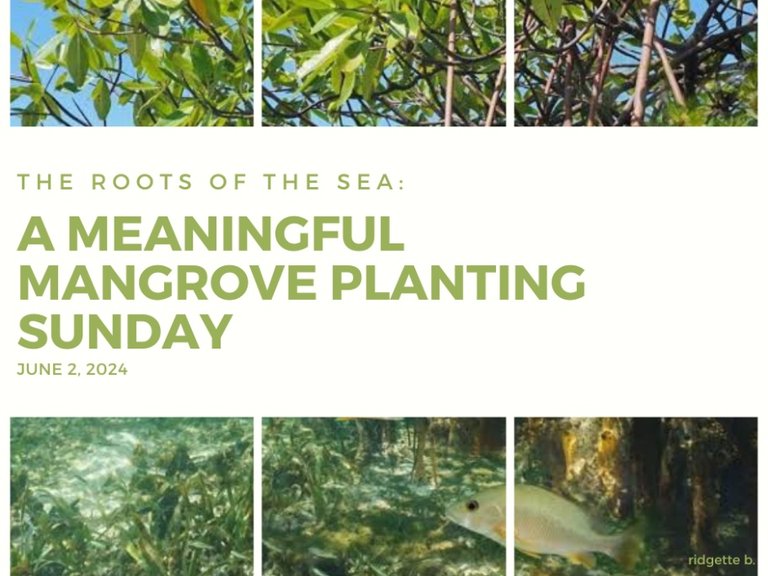
"If there are no mangroves, then the sea will have no meaning. It's like a tree with no roots, for the mangroves are the roots of the sea."
—Mad-Ha Ranwasii, Thai Fisherman & Village Headman
Konnichiwa Hivers! It's me, your ridgette, and for today, I'm going to share with you all my mangrove planting experience last Sunday. Same with my usual new experiences, it turned out different than I expected it to be. So now join me as I reminisce about my first ever mangrove planting.
I didn't know the location!

I was really upset when I discovered that we needed to go directly to our rendezvous place because I knew I didn't have any idea where exactly it was. I tried to ask my classmates where exactly it was located, but they just gave me vague answers. These answers didn't help me at all; instead, they confused the hell out of me because each person that I asked had a different description of it. It was almost 1:00 p.m. and our meeting time is at 2:00, so I have no choice but to get moving because time is really running. I arrived in Naga City just before 1:30, so even though I didn't have an idea where the said Alferez Beach Resort was, I followed the clue and headed towards the street, which I thought would lead me towards the ocean.
Lost for a Moment!
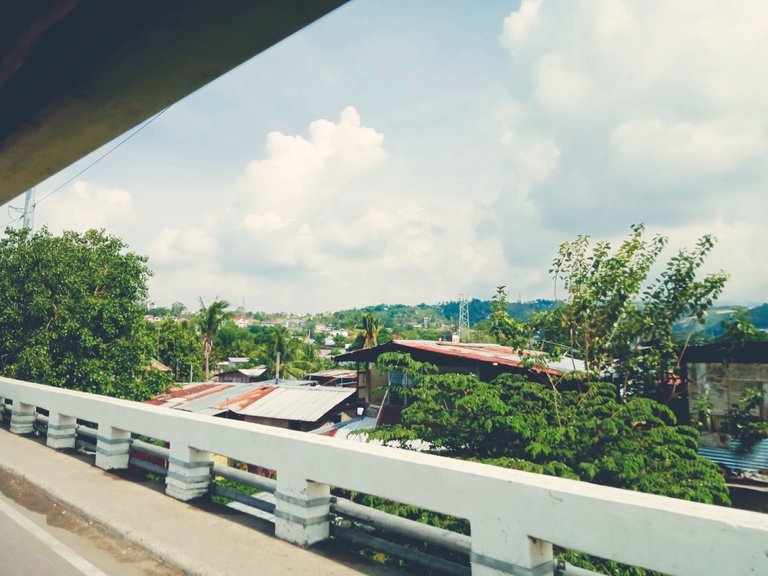
I know that there is definitely something wrong, but I just continued walking inside the familiar street. Minutes later, I saw some familiar faces, and when they got near, I recognized them. They are my classmates! Relief flooded in me when I saw them, and they are somehow puzzled as to where I am going because the street that we're on is far from the rendezvous place. It turns out that the street they are referring to is the next street. I really thank God because if I hadn't met them, I would really go further inside that familiar street. It turns out my instinct was wrong that time.
Towards the Beach

Since the classmates whom I met weren't also sure where exactly the Alferez Beach Resort was, we decided to just ride an e-bike to get there. Since we are many, we somehow got a bargain for our fare. The direction towards the beach was really confusing, especially for me, who's not really familiar with the entire place. We entered a lot of streets, which I wasn't familiar with, and I guess now I already forgot where those streets were. After an almost ten-minute ride, we finally arrived at the said beach resort.
Into the Sea
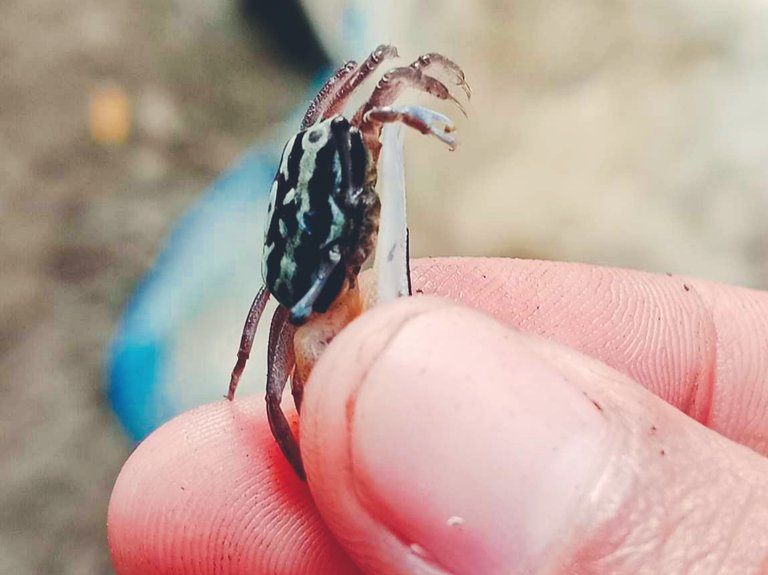
When I arrived, they were already busy tying the bani (dried banana trunk) to the bamboo sticks. These sticks will be later used to help the mangrove seedlings grow up straight. After a few minutes of waiting further for our other classmates, at past 2:00 in the afternoon, we decided to leave to go to the actual mangrove planting site. I think we walk for almost 5 minutes before we reach the actual planting site. It was low tide at that time, and there were a lot of agokoy (fiddler crabs).
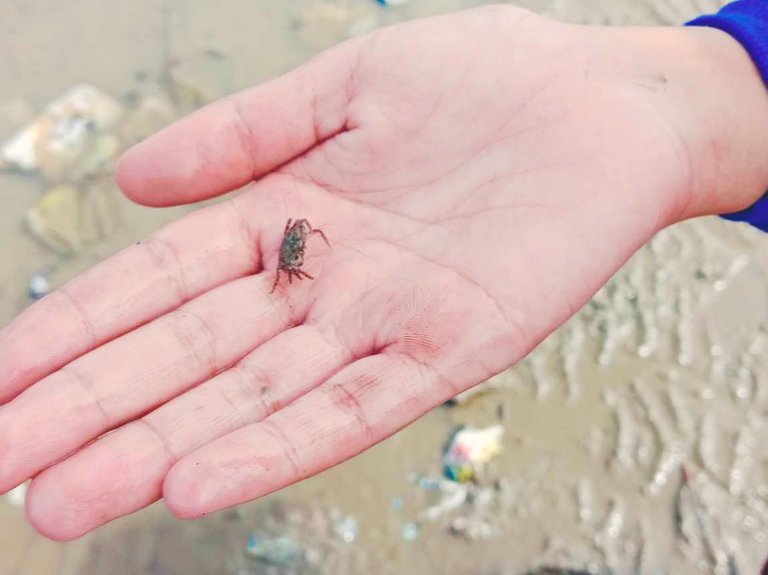
Most of them are so tiny, and of 'course they're incredibly fast to hide inside the tiny holes in the sand. I tried catching some of them, and indeed, they're so small! It's fun to watch them hide whenever my shoes set foot on the muddy sand. I catch more than five of them, and after taking a picture, I let them go. The moment I put it back on the sand, it immediately scrambled its way towards the sand holes. They're indeed interesting creatures to watch!
The Planting Prep!
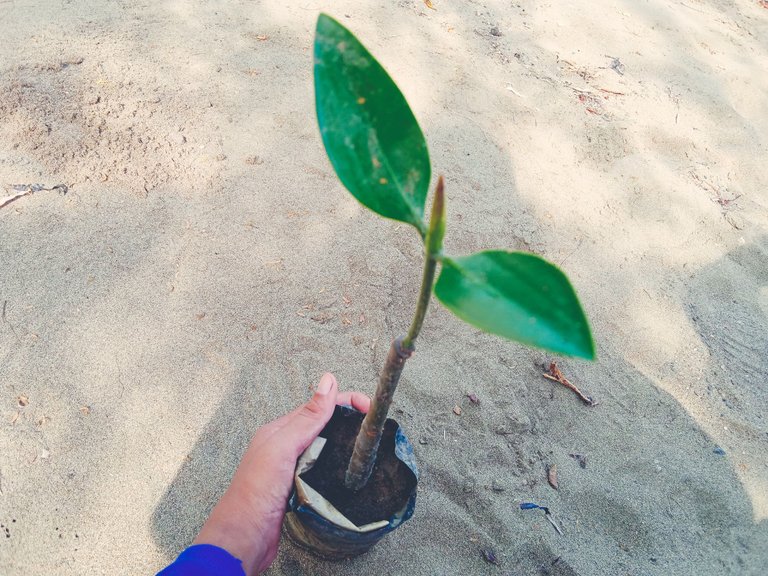
After we're given the mangroves that we were to plant, a personnel from C-ENRO gave a brief orientation about the mangroves we're about to plant. He explained that before, they also planted mangrove propagules, but later they found out that these propagules had a low survival rate. They decided to try growing mangrove seedlings, and indeed, these seedlings have a higher survival rate than those propagules. That's why, now, they strongly suggest to those people who want to plant mangrove that they just buy mangrove seedlings from the locals because these seedlings have a higher survival rate. Also, those seedlings give extra income to the locals who grow them.

After the orientation, we finally left the sandy part of the beach. We then proceed to the muddy part, but before that, we of 'course have a photo op with the mangroves we're going to plant.
It's Planting Time
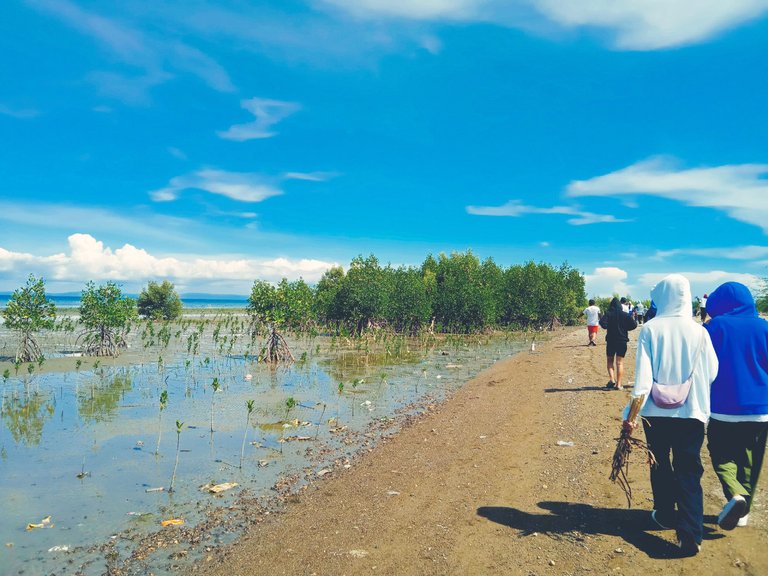
Earlier, I tried to walk on the muddy sand with my shoes on, but it only led to my shoes getting stuck on it. It almost took me a minute to take my shoes and feet out of the mud. I learned my lesson that time, and when we're about to plant those mangroves, I take off my shoes and walk barefoot on the mud. I was quite nervous at first because the mud is really sticky, and I'm really afraid that there might be a leech in the mud.
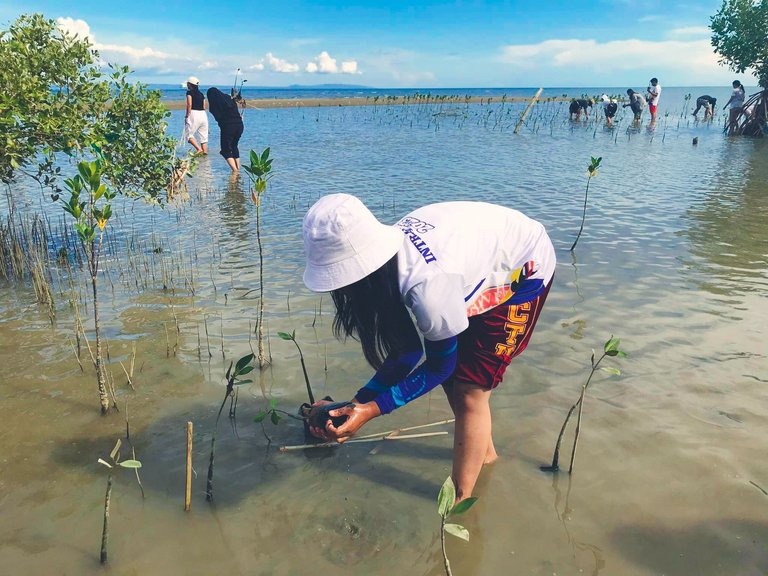
Despite my worry about the leech, I continued to walk on the muddy planting site, and I looked for a spot to dig a hole. With the bamboo stick I have, I dig up the muddy sand. I tried to stoop a little, but the water reached my clothes, so I decided to just kneel on the muddy sand so that I could dig better.

After a few minutes of digging, I finally dug a decent hole for my mangrove seedlings. Before I removed the black plastic pots, I ensured that the soil was clumped with the seedling's roots. Then, I put it in the hole and put the muddy sand on it.
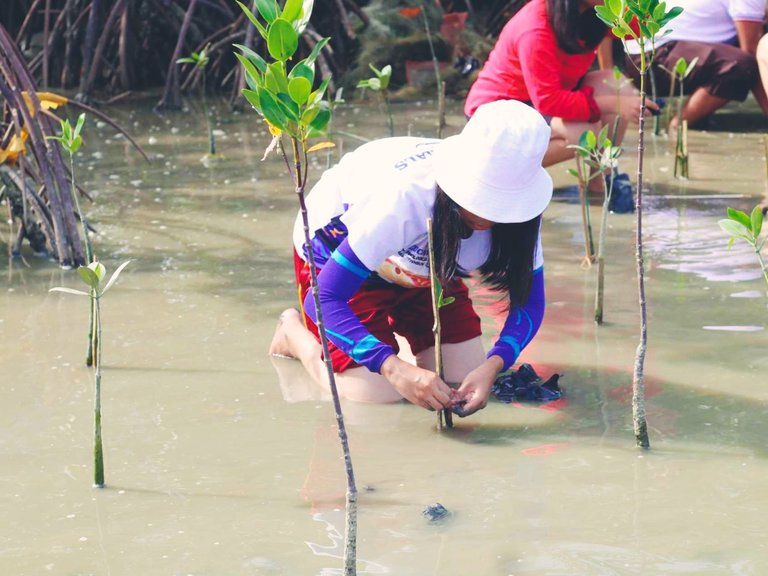
After securing that it was already planted well, I got the bamboo sticks and put them near the seedlings. Then I tied the bani and the mangrove stem to the bamboo stick to ensure that they wouldn't be carried away by the harsh waves. Having planted all of the three mangroves, I first secured that they were properly tied to the bamboo sticks, then I left them because I also wanted to see what my classmates were doing.

Savoring the Sea Breeze
After planting the mangroves, we stayed for a while on a sandy part near the planting site. The sea breeze was really calming, and the waves were mesmerizing to watch. When all of us were finished, our instructor decided to spend a moment in the sandy part and take the group photo there.

Going Home
After the photo op, we get out our stuff, then proceed to our clean-up drive. While we were going back to the Alferez Beach Resort, we picked up trash along the way. Plastic wrappers, bottles, sacks, and all sorts of trash and junk are littered across the coastal line. Some of them are really hard to pick up because they got stuck in the mud and sand for a long time. By the time we're near the beach resort, our sack is really heavy. There wasn't much trash in there, but I think it's the water, mud, and sand that made it heavier.
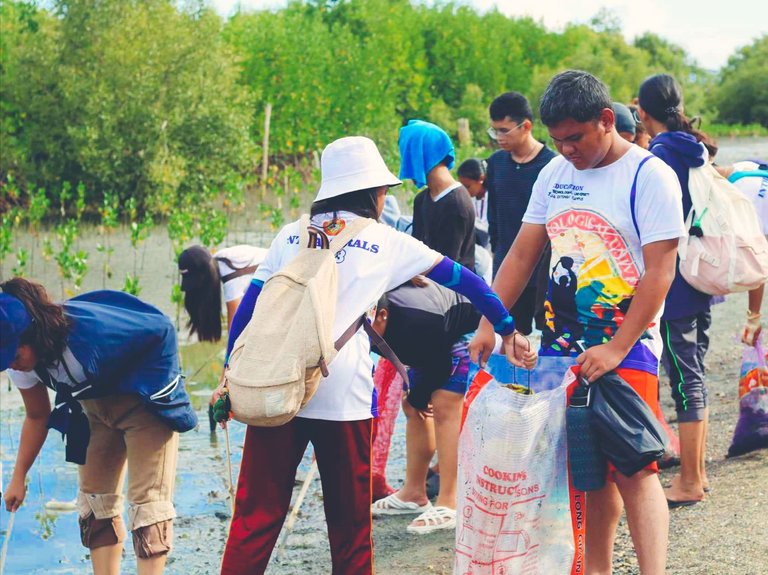
Just before our activity ended, we had an attendance check. Our activity ended with a group photo op, and of 'course, after that, it was home sweet home.

According to Conservation International, mangroves are one of nature's best defenses against climate change. Mangroves protect us from erosion and storms. Further, they reduce flooding, and they are also essential in capturing and storing large amounts of carbon dioxide from the atmosphere, thus helping to slow down the effects of the ever-threatening climate change.
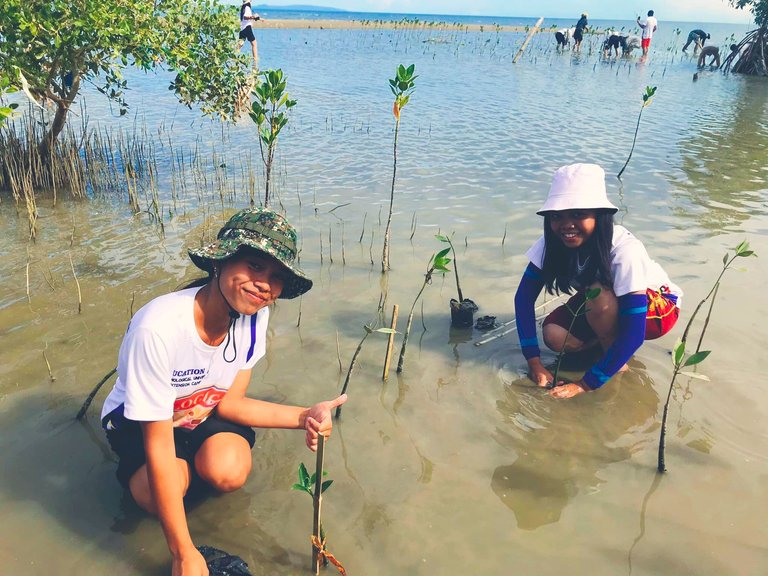
Mangroves also serve a vital role in our coastal ecosystem, for they provide habitat for fish and other land and marine creatures such as crabs, shrimps, and even different kinds of birds. Mangroves are indeed important; that's why let's plant more mangroves to secure a better future. Let us all treasure the place where land and sea creatures both thrive—the mangroves.
The first picture was edited in Canva, while the rest were taken by my classmate/s or by yours truly, ridgette.
Wow! Good job Ma'am @ridgette the best way of giving back to our environment.
Certainly ma'am! Thanks for stopping by @diamondinthesky! See you around!
You did a great job, miss @ridgette!!! Haaayy it must be so full filling to plant Mangroves noh? Knowing you are part of the peeps out there who preserved mangroves for the sea. Bow down to you pooo 🫶🫶🫶
Thank you @douceink, yeah it was really fulfilling to plant those mangroves. It was fun and at same time it's like giving back to our environment. By the way thanks for stopping by! See you around!